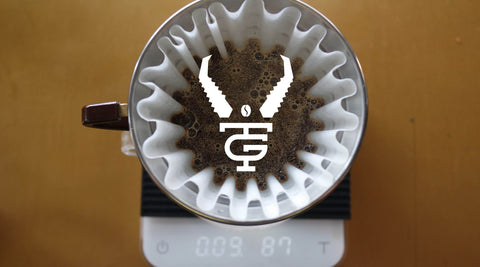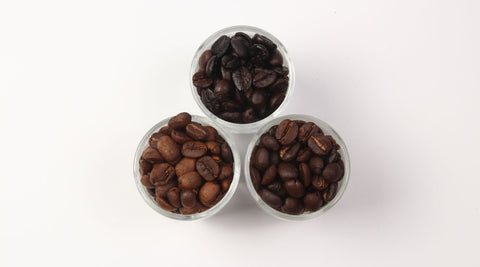Understanding what is a coffee bloom, or blooming coffee as a whole boils down to two main components and contributing factors, the freshness and how soon after you brew the coffee once the beans are ground.
And even during those hot summer months, cold brew coffee in the morning can give you just the refreshing kickstart needed to tackle the day ahead.
What is bloom coffee?
Coffee blooming is quite straightforward. As you add hot water to ground coffee beans you will see bubbling and foaming as carbon dioxide repels water and is released from the beans.
The bigger the bubbles the fresher the blend.
What is the purpose of a Coffee Bloom?
You want the maximum flavor extracted from your coffee bean into the water and this only happens when the carbon dioxide is allowed to escape.
Bloom coffee comes from extracting the oils and aromas of the beans into the hot water and gives us that fresh flavor we seek to get out engines running in the morning.
Coffee Bloom Explained: Direct From The Roaster
There is so much more to making a great cup of fresh coffee than simply adding hot water to store-bought ground coffee.
Why sacrifice setting a great tone for the day by opting for less than quality when it comes to making your morning cuppa?
The main components, when considered and executed well, can result in a rich, aromatic carafe of freshly roasted coffee and set the tone for the day ahead. Let's see what that ingredient is.
Carbon Dioxide
Carbon dioxide is not the first thing that comes to mind when we think about coffee, yet every coffee bean contains carbon dioxide at the start of its growing process until it is harvested.
As soon as they are roasted the gas begins to escape, therefore, the darker the roast the less CO2.
Importance of the Coffee Bloom
The carbon dioxide repels water thus if we do not take time to bloom coffee grounds the gas cannot be released and the water cannot be absorbed by the beans and extract the flavors into the liquid we have come to know and love as coffee.
Storage of Beans Makes a Difference
Those magazine-worthy transparent canisters you hoped would be elegantly laid out on your kitchen counter to display your arrangement of goodies, one being coffee grounds or beans, will have to change.
Not only is air one of the greatest downfalls of your once-fresh coffee beans, but so is light, which in excess, affects the bean taste.
You ideally want to keep your coffee in an airtight container and at room temperature. Many people think if you keep the coffee in the fridge or freezer it will last longer, this is not true.
They will still age as quickly, but they will absorb the smells of the foods around them.
And the last thing anyone wants to sip first thing in the morning is a cup of coffee that tastes like grilled chicken, no thank you.
Tips For Blooming With Different Brewing Methods
Like with all things we have options, and it is no different to coffee brewing. The brewing process and brewing device however may make a difference to your coffee brewing routine in the morning.
Automatic Drip Coffee Makers
Freshly toasted beans still make an impact when using an automatic coffee machine, but unlike a manual espresso machine, you want to have all your ingredients ready together before beginning.
Just like the French press you want to ensure the coffee roasted is fresh for maximum flavor, and you've allowed the carbon dioxide escape to be completed.
Let the filter basket fill the neck of the canister and then add freshly ground coffee (dark roast works great) and top up with water - usually twice the weight of coffee.
Pour Over
Unlike your generic coffee maker a pour-over coffee is quick and beginner-friendly, but using fresh coffee grounds and allowing the coffee to bloom is still as important for a flavorful cup.
You want to bloom your coffee with a medium coarse grind and awaken the degassing process to allow the CO2 to escape (and any other volatile compounds). But keep an eye out so as not to over-extract or end up with a sour taste.
French Press
Similar to a drip coffee maker a French press has the blooming and brewing method essentially built-in, and while it is a longer roasting process whereby the coffee grounds are dripping wet with the water (not cold water) seeping through and taking all those decadent flavors with it.
Be sure to measure the grams of water in the coffee so as not to let the carafe overflow with the ready coffee at the end of the roasting process.
Cold Brew
Simply put you measure your ground coffee and grams of water, combine them, and allow them to steep and intensify overnight. Using dark roasts results in a smoky, aromatic mouthfeel, as the gas release has been maximized.
Espresso Machine
You can never exactly measure how much gas has or hasn't been released during blooming (we only gauge by time), but allowing the grounds to be soaked before brewing (this is called pre-infusion) will give you a better-tasting cup of coffee.
The flavor compounds are extracted into the water as you add pressure and water is passed through the filter.
Factors That Can Affect the Blooming Process
Several factors can negatively, or significantly affect the blooming process, some you may understand, and others we don't necessarily consider until we recognize the signs.
Let's see what some of those elements are and how we can prevent them from happening by making small changes, or rectifying what we are doing to encourage a better bloom.
-
Bean density - As coffee ages so does the quantity of gas inside the bean which affects the bean hardness. The less carbon dioxide present the lower and less effective the coffee bloom, you can tell by the hardness of the beans when you touch them.
-
Coffee freshness - When your bean blend is freshly roasted there will be big bubbles and you can maximize the extracting flavor.
-
Grind size - The size of the coffee grinds offers a larger surface area for carbon dioxide to be released. Freshly roasted coffee blooming should only occur with coffee grounds that have only recently been ground down to size.
-
Water Temperature - Good heat is essential in the blooming and brewing process. When the water temperature is high both of these stages will happen much more quickly. It is no secret that matter dissolves more quickly in hot water than in cold.
-
Coffee-to-water ratio - The most common ratio, unless you are making traditional Turkish coffee, is a 2:1 water-to-coffee ratio.
-
Roast Degree - With the darker beans most of the flavors and caffeine roast out. This is why the darker bean roasts have a smoky, oily flavor profile.
Fresh Roasted Versus Ground Coffee
Fresh beans or ground beans, does it matter?
When you have a fresher batch of coffee beans it equals more carbon dioxide present which, in turn, gives a bigger bloom.
If you don't see a big bloom bubble it is more than likely your coffee beans are stale and not freshly roasted coffee.
Coarsely ground coffee on the other hand has a similar effect to brewed coffee when using a pour-over coffee technique, only without the pour-over stage.
Simply pour hot water over the coffee grounds in a circular motion moving from the center towards the outside ensuring everything is thoroughly soaked and leave to sit for 30 - 45 seconds.
Then fill the rest of the carafe or brewing container with the remaining water to continue the brewing process.
Can you let the coffee bloom too long?
Yes, you can bloom coffee for too long.
Master baristas and veteran coffee drinkers have shown that 30 seconds is the ideal blooming period for freshly roasted coffee and anything longer than 45 seconds will result in a higher quantity of carbon dioxide and your coffee will become acidic.
This sour taste comes from the bloom being over-extracted with too many of the rich, somewhat sour oils being drawn out.
You are better off with an under-extracted coffee during the brewing process.
Why Doesn't My Coffee Bloom?
The most common reason for an ineffective bloom is the freshness of the coffee beans, and often they are not the quality of freshness you need for a generous bloom.
Many coffee enthusiasts claim that light or medium roasts show a larger bloom than their darker roasts counterparts, but, in general, there should still be some evidence albeit subtle.
Coffee Bloom: Fresh Is Best
Who would have thought carbon dioxide would be the key to a well-made cup of coffee, yet here we are. The combination of gas and organic material such as the humble bean gives us something many of us can not live without, or at least need one cup of per day to keep the engines running.
Using freshly roasted beans or pre-ground, always opt for the highest quality of ingredient you can afford, after all, if you only have one cup, you better make it a great one, right? And when the best flavor compounds come together, you can't go wrong and you will have fresh roasted coffee everytime.


